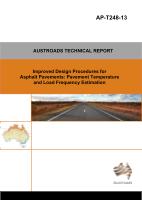Pavement

Improved Design Procedures for Asphalt Pavements: Pavement Temperature and Load Frequency Estimation
- Publication no: AP-T248-13
- ISBN: 978-1-925037-22-7
- Published: 27 September 2013
- PDF (free) Download
This report documents a study designed to predict temperature and load frequency in asphalt pavements and their effect on the modulus of the asphalt material. It is the first report from a three-year Austroads project which aims to improve the design procedures for asphalt pavements in Australia.
As part of the study the procedures for the estimation of load pulse duration and for pavement temperature calculation in the current Austroads Guide were reviewed and compared to international practice.
A pavement temperature prediction method was calibrated against local historical pavement temperature data. The accuracy of the developed model is considered to be suitable for use in asphalt pavement design.
- 1. Introduction
- 1.1. Background
- 1.2. Problem Statement
- 1.3. Objectives
- 1.4. Report Structure
- 2. Effect of Temperature and Loading Speed on Modulus
- 2.1. Modulus Master Curves
- 2.2. Effect of Temperature and Load Frequency on Modulus at Depth
- 2.2.1. The Effect of Load Pulse Duration
- 2.2.2. The Effect of Pavement Temperature
- 2.2.3. The Combined Effect of Temperature and Load Frequency
- 3. Modulus Master Curves
- 3.1. Asphalt Modulus in the Austroads Guide
- 3.2. Complex Modulus Testing
- 3.2.1. Differences between Complex Modulus and Flexural Modulus
- 3.2.2. Construction of the Master Curve
- 4. Review of Relationships to Relate Laboratory Loading Rates to Loading Rates in Service
- 4.1. Early Work on Load Pulse Duration
- 4.2. The Austroads Method
- 4.3. CalME and MEPDG
- 4.4. Conversion between Field and Laboratory Modulus
- 4.5. Discussion
- 5. Temperature Prediction Models in Asphalt Pavement Design
- 5.1. Shell Pavement Temperature Model
- 5.2. Australian Work on Pavement Temperature Prediction Models
- 5.3. Predicting the Surface Temperature using the Energy Balance Concept for Heat Transfer
- 5.4. Predicting Temperature at Depth
- 5.5. Modelling the Diurnal Pavement Temperature Profile
- 6. Development of Australian Pavement Temperature Prediction Model
- 6.1. Availability of Local Pavement Temperature Data
- 6.2. Prediction of the Maximum Pavement Surface Temperature
- 6.2.1. Direct Solar Radiation
- 6.2.2. Long Wave Radiation
- 6.2.3. Convection
- 6.2.4. Conduction
- 6.2.5. Summary of Input Values and Defaults
- 6.2.6. Pavement Surface Temperature Prediction Model Calibration
- 6.2.7. Maximum Surface Temperature Prediction Model for Hot Cloudless Days
- 6.2.8. Adjusting the Model for Cloudy Days
- 6.3. Selection of Minimum Surface Temperature Prediction Model
- 6.4. Selection of Models for the Prediction of the Diurnal Pavement Temperature Profile and the Temperature at Depth
- 6.5. Validation of the Prediction Model against Pavement Temperature Distribution Data
- 7. Experiment Design
- 7.1. Experiment Locations
- 7.2. Instrumentation and Data Collection
- 8. Conclusions
- 8.1. Influence of Load Duration and Temperature on Asphalt Modulus
- 8.2. Review of Procedure for Load Pulse Duration
- 8.3. Temperature Prediction Models
- 8.4. Further Work
- References
Related publications
WEB-R708-24
Latest Pavement News
